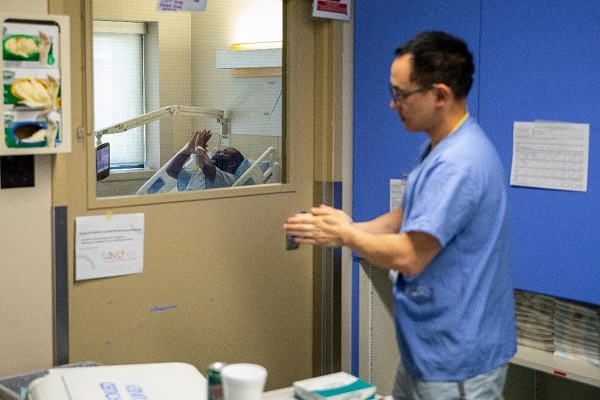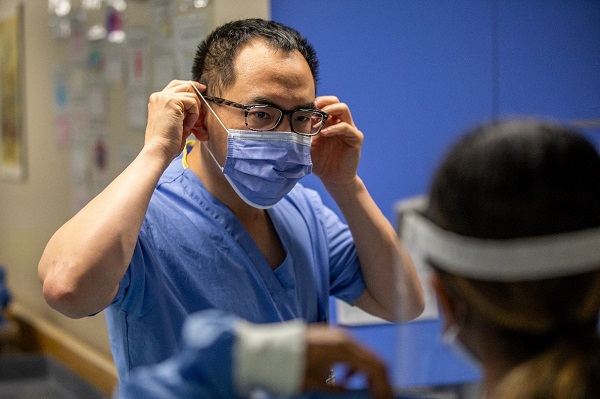


Dr. Steven Wong is a General Internist on St. Joe’s COVID-19 unit.
St. Joe’s COVID-19 unit: A day in the life of Dr. Steven Wong
It’s morning on the COVID-19 unit and Dr. Steven Wong, a General Internist, is reviewing the medical charts of patients admitted to hospital overnight as infection rates climb in the community.
Some patients have come from the emergency room, breathless and scared. Some from the intensive care unit (ICU), hopeful to go home after life-saving treatment. Others were transferred from hospitals a distance away, apart from their family and loved ones.
“The mornings are always the busiest,” Dr. Wong says, as he assesses which patients will need immediate attention, and which he can visit later in the day.
While the story of how each patient arrived to the unit is different, they share one thing in common. Those hospitalized during the third wave of COVID-19 are younger, and declining at a more rapid rate.
“In internal medicine, we don’t see young patients, and now that’s all we’re seeing on the COVID-19 unit,” Dr. Wong says. “It’s not just people in their 60s and 50s. Now, it’s people in their 40s, 30s, and 20s – and they’re really sick. It’s a completely new disease, and a whole new problem to solve.”

Dr. Wong attends to his patient, André Smith, 43, who spent five days in St. Joe’s ICU before being cared for on the COVID-19 unit.
The third wave: “A completely new disease”
In a long hallway, patients lie in isolation behind closed doors in rooms where they are given oxygen therapy. Some rooms have windows on the doors, allowing the care team to peek in periodically. Others do not, and baby monitors offer a glimpse inside.
Before Dr. Wong enters a patient’s room, he sanitizes his hands and puts on fresh personal protective equipment (PPE), including gloves, a gown, face shield, and surgical mask. Upon exiting a room, the process is repeated in reverse, and done over again down the hallway.
“The third wave is totally different,” Dr. Wong says. “It’s shocking because we felt like we just got an understanding of what COVID-19 is like, and what patient trajectories are like, and it all changed.”
A silver lining to the unprecedented pressures of COVID-19 on health care has been the accelerated pace of scientific discovery, he says.
“In the beginning, we were hoping anything would work,” Dr. Wong says, adding the COVID-19 unit is home to a number of studies to learn more about the virus.
As well as proven drugs to treat COVID-19 symptoms, the care team turns to techniques such as proning – placing patients onto their stomach – to allow those in respiratory distress to breathe more easily.
“Now, at least, we have a developed standard of care,” Dr. Wong says.

The COVID-19 unit takes a team-based approach to delivering care to patients with the hope they will get better, and home, soon.
Younger patients: “It just doesn’t feel right”
Dr. Wong joins members of the care team, including nurses, physiotherapists, social workers, and dietitians, in a conference room.
He stands against a screen with the names of each patient on the unit. Some patients share surnames as they are family members. The state of their condition, and their ages, are also listed.
“Personally, seeing such young patients is unsettling,” Dr. Wong says. “It just doesn’t feel right. It’s not what we normally do – I mean we take care of patients, but not so many young patients. It’s not something we expected.”
In doing his rounds, Dr. Wong discusses who is cleared to go home after a series of negative COVID-19 tests, and who is deteriorating and needs intervention.
“It goes beyond medical care,” Dr. Wong says. “We talk about what else they need for their physical and psychosocial health.”
The group reviews each patient’s care plan. In the case of worsening symptoms, some patients have requested intensive care support, while others opt for end-of-life treatment.

After exiting each patient’s room, Dr. Wong sanitizes his hands before putting on fresh PPE, and going into the next room.
Coping as a team: “You have to take this seriously”
As the rest of the day unfolds, Dr. Wong continues checking in on patients.
He meets with nurses, residents and physician assistants to talk about the ongoing needs of the day, and to prepare for a new wave of patients to arrive by morning.
“The day is always punctuated by severely ill patients,” he says. “If there are major issues overnight, we get involved with the residents and the ICU, if needed.”
He gives kudos to the team on the COVID-19 unit for their dedication. Since the first wave, they have worked tirelessly to deliver compassionate care to patients, support their families and loved ones, and serve the community.
“The people who are really amazing are the ones who have been here every day non-stop since the beginning,” he says. “There’s so much pressure on the healthcare system to create capacity, a lot of concern about patients, and the strain on our healthcare workers, so there’s a lot of stress – it’s really challenging.”
Asked what he would say to the community right now, Dr. Wong is quick to answer.
“People of all ages need to follow public health guidelines and get the first vaccine they are offered,” he says. “Even if you’re young, you have to take this seriously. You’re doing it to protect yourself, but also someone else in your age group who could get sick and end up in hospital.”


